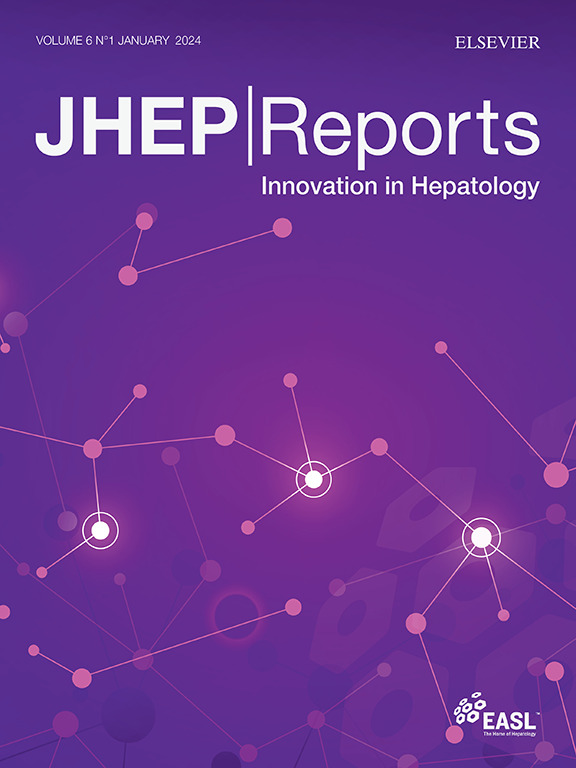Prioritising viral hepatitis elimination to prevent hepatocellular carcinoma: A public health approach for effective preventive hepatology
IF 7.5
1区 医学
Q1 GASTROENTEROLOGY & HEPATOLOGY
引用次数: 0
Abstract
Hepatocellular carcinoma (HCC) is the most common type of primary liver cancer, accounting for about 70-80% of cases globally. The hepatitis B and C viruses (HBV and HCV) account for approximately 70% of all HCC cases worldwide, with variation across geographic regions. While progress has been made in achieving some of the World Health Organization's viral hepatitis elimination targets set for 2030, considerable action is still needed to achieve global viral hepatitis elimination. Although numerous viral hepatitis prevention strategies, including vaccination against HBV, have proven successful, considerable gaps and challenges remain in their implementation. Likewise, monitoring for additional risk factors for HCC continues to be insufficient. This is particularly important given that the burden of viral hepatitis is further compounded by the high and rising prevalence of steatotic liver disease (formerly called fatty liver disease), a growing global concern and a major HCC driver. A more comprehensive approach to HCC prevention is critical and we propose an evolving narrative which emphasises an expanded understanding of “preventive hepatology” as a framework. Preventive hepatology recognises that the growing burden of liver cancer, mainly HCC, can be effectively addressed through the prevention and treatment of viral hepatitis, with additional, targeted preventive measures being applicable for populations at risk, through screening and surveillance. A more holistic approach to HCC prevention should include primary prevention strategies for the early detection and timely treatment of viral hepatitis and steatotic liver disease. It should also include HCC surveillance among people living with chronic viral hepatitis infection, particularly those living with cirrhosis, those cured of HCV, and the management of additional risk factors associated with other HCC aetiologies.

优先消除病毒性肝炎以预防肝细胞癌:有效预防肝病学的公共卫生途径
肝细胞癌(HCC)是最常见的原发性肝癌类型,约占全球病例的70-80%。乙型和丙型肝炎病毒(HBV和HCV)约占全球所有HCC病例的70%,不同地理区域存在差异。虽然在实现世界卫生组织为2030年制定的消除病毒性肝炎的一些具体目标方面取得了进展,但仍需采取大量行动,以实现全球消除病毒性肝炎。尽管包括乙肝疫苗接种在内的许多病毒性肝炎预防战略已被证明是成功的,但在实施方面仍存在相当大的差距和挑战。同样,对HCC的其他危险因素的监测仍然不足。鉴于脂肪肝(以前称为脂肪肝)的高发病率和不断上升的患病率进一步加剧了病毒性肝炎的负担,这一点尤为重要,脂肪肝是全球日益关注的问题,也是HCC的主要驱动因素。一个更全面的预防HCC的方法是至关重要的,我们提出一个不断发展的叙述,强调扩大对“预防性肝病学”的理解作为一个框架。预防肝病学认识到,通过预防和治疗病毒性肝炎,可以有效地解决肝癌(主要是HCC)日益增加的负担,并通过筛查和监测,对高危人群采取额外的、有针对性的预防措施。一个更全面的预防HCC的方法应该包括早期发现和及时治疗病毒性肝炎和脂肪变性肝病的一级预防策略。它还应包括慢性病毒性肝炎感染者的HCC监测,特别是肝硬化患者、丙型肝炎治愈者,以及与其他HCC病因相关的其他危险因素的管理。
本文章由计算机程序翻译,如有差异,请以英文原文为准。
求助全文
约1分钟内获得全文
求助全文
来源期刊

JHEP Reports
GASTROENTEROLOGY & HEPATOLOGY-
CiteScore
12.40
自引率
2.40%
发文量
161
审稿时长
36 days
期刊介绍:
JHEP Reports is an open access journal that is affiliated with the European Association for the Study of the Liver (EASL). It serves as a companion journal to the highly respected Journal of Hepatology.
The primary objective of JHEP Reports is to publish original papers and reviews that contribute to the advancement of knowledge in the field of liver diseases. The journal covers a wide range of topics, including basic, translational, and clinical research. It also focuses on global issues in hepatology, with particular emphasis on areas such as clinical trials, novel diagnostics, precision medicine and therapeutics, cancer research, cellular and molecular studies, artificial intelligence, microbiome research, epidemiology, and cutting-edge technologies.
In summary, JHEP Reports is dedicated to promoting scientific discoveries and innovations in liver diseases through the publication of high-quality research papers and reviews covering various aspects of hepatology.
 求助内容:
求助内容: 应助结果提醒方式:
应助结果提醒方式:


